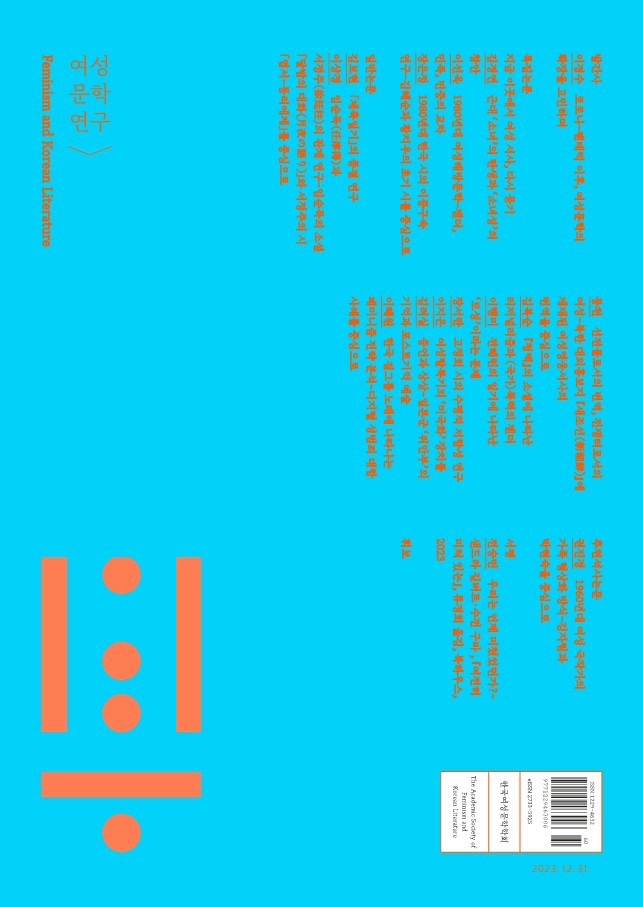- ENGLISH
- P-ISSN1229-4632
- E-ISSN2733-5925
- KCI
 ISSN : 1229-4632
ISSN : 1229-4632
모성 다시 쓰기의 의미 : 박완서론
From "Motherhood" to "Mothering"-The Study of Park, Wan-Seo
초록
이 논문은 박완서 소설이 왜 어머니를 다시 쓰고 있는가, 어머니 다시 쓰기에서 새롭게 발견한 의미는 무엇인가를 밝히려는 글이다. 박완서는 전쟁과 오빠의 죽음이라는 동일한 소재를 세 번의 장편으로 다시 쓰고 있다. 『나목』, 「엄마의 말뚝」 연작, 『그 많던 싱아는 누가 다 먹었을까』와 『그 산이 정말 거기 있었을까』 연작이 그것이다. 전쟁과 오빠의 죽음이라는 자전적 요소는 허구성과 사실성이 결합되는 방식을 달리 하면서 재구성되는 특징을 보이고 있다. 등단작인 『나목』이 가장 허구화된 측면을 보여준다면, 점차 사실성으로 접근해가면서 『그 많던~』은 가장 날 것의 경험을 드러내고 있다. 이 과정에서 볼 수 있는 가장 큰 변화는 오빠의 죽음과 관련된 내용이다. 『나목』에서 오빠들의 죽음은 순결한 젊은이의 죽음이라는 점이 강조되고, 어머니는 아들의 죽음과 함께 자신을 유폐시키는 가부장적 어머니로 그려진다. 그리고 딸은 아들의 어머니로만 존재하려는 그녀에 대한 환멸을 드러낸다. 그러나 어머니의 역사에 대한 부정은 여성 자신이 자기 역사를 부정하는 것이 된다. 『그 산이~』에서 오빠는 죽음에 대한 공포로 영혼이 먼저 무너져 내린 처참한 모습으로 그려진다. 어머니 역시도 그 공포와 먹고살기의 비루함을 함께 겪은 공모자일 뿐 흔들림 없이 아들을 지켜내는 대지의 모신과는 거리가 멀다. 탈역사화되었던 어머니가 역사화되는 것이다. 이러한 변화는 색의 기억에서 맛과 먹고살기의 기억으로 변화하는 특징과도 맞물려 있다.
- keywords
Abstract
This thesis is trying to clarify why Wan-Seo Park's novel is rewriting about "mother" and what the new-found meaning of "mother" is by rewriting it. Park, Wan-Seo is writing about the same subject-war and the death of her elder brother in three different novels. The three different novels are the Namok, Uhm-ma ui Malttook series, Geu Mahntun Shinga neun nooga dah mugutseulkka and Geu Sahn e jungmal guhghi itsut sulka series. The characteristics of these novels are that the author's autobiographical aspects of war and her brother's death is shown by weaving through fiction and non-fiction. If her maiden work Namok shows the most fictitious aspects, Geu Mahntun Shinganeun nooga dah mugutseulkka comes close to non-fiction showing a lot of personal experiences. In this process the most change comes in the author's view of her elder brother's death. In Namok she emphasizes that the death of her brother is the death of a immaculate youth. At the same time the mother is shown as a patriarchal mother who incarcerates herself with the death of her son. The daughter shows the disillusionment that she has against her mother who tries to remain as just the mother of the son and not the daughter. But denying the history of her mother the author realizes that it also represents herself denying her own history. The brother's soul is already falling apart in a gruesome way due to the fear of dying in Geu Sahn e~. The mother is also sharing the fear of death with her brother and feels contempt with trying to live another day. She is described as a conspirator and is far from the sturdy Maternal God of earth that protects her son. This is when the mother is becoming a part of history again. These changes are seen in the novel as the change from memories of color to the change of taste and everyday living.
- keywords
- 다운로드 수
- 조회수
- 0KCI 피인용수
- 0WOS 피인용수
